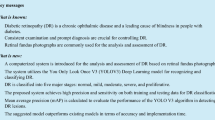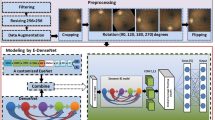Abstract
Purpose
The purpose of this study is to develop and validate the intelligent diagnosis of severe DR with lesion recognition based on color fundus photography.
Methods
The Kaggle public dataset for DR grading is used in the project, including 53,576 fundus photos in the test set, 28,101 in the training set, and 7,025 in the validation set. We randomly select 4,192 images for lesion annotation. Inception V3 structure is adopted as the classification algorithm. Both 299 × 299 pixel images and 896 × 896 pixel images are used as the input size. ROC curve, AUC, sensitivity, specificity, and their harmonic mean are used to evaluate the performance of the models.
Results
The harmonic mean and AUC of the model of 896 × 896 input are higher than those of the 299 × 299 input model. The sensitivity, specificity, harmonic mean, and AUC of the method with 896 × 896 resolution images as input for severe DR are 0.925, 0.907, 0.916, and 0.968, respectively. The prediction error mainly occurs in moderate NPDR, and cases with more hard exudates and cotton wool spots are easily predicted as severe cases. Cases with preretinal hemorrhage and vitreous hemorrhage are easily identified as severe cases, and IRMA is the most difficult lesion to recognize.
Conclusions
We have studied the intelligent diagnosis of severe DR based on color fundus photography. This artificial intelligence–based technology offers a possibility to increase the accessibility and efficiency of severe DR screening.



Similar content being viewed by others
References
Yang W, Lu J, Weng J et al (2010) Prevalence of diabetes among men and women in China. N Engl J Med 362(12):1090–1101
Chan JC, Zhang Y, Ning G (2014) Diabetes in China: a societal solution for a personal challenge. Lancet Diabetes Endocrinol 2(1):969–979
Bellemo V, Lim G, Rim TH et al (2019) Artificial intelligence screening for diabetic retinopathy: the real-world emerging application. Curr Diab Rep 19(9):72
Knuth DE (1997) The Art of Computer Programming, Volume 2: Seminumerical Algorithms. Addison Wesley Longman, 145–146
He K, Zhang X, Ren S, et al (2016) Deep residual learning for image recognition. Proceedings of the IEEE conference on computer vision and pattern recognition. 770–778.
Li Z, Keel S, Liu C et al (2018) An automated grading system for detection of vision-threatening referable diabetic retinopathy on the basis of color fundus photographs. Diabetes Care 41(12):2509–2516
Abràmoff MD, Lou Y, Erginay A et al (2016) Improved automated detection of diabetic retinopathy on a publicly available dataset through integration of deep learning. Invest Ophthalmol Vis Sci 57(13):5200–5206
Gulshan V, Peng L, Coram M et al (2016) Development and validation of a deep learning algorithm for detection of diabetic retinopathy in retinal fundus photographs. JAMA 316(22):2402–2410
Gargeya R, Leng T (2017) Automated identification of diabetic retinopathy using deep learning. Ophthalmology 124(7):962–969
Ting DSW, Cheung CY, Lim G et al (2017) Development and validation of a deep learning system for diabetic retinopathy and related eye diseases using retinal images from multiethnic populations with diabetes. JAMA 318(22):2211–2223
Abràmoff MD, Lavin PT, Birch M et al (2018) Pivotal trial of an autonomous AI-based diagnostic system for detection of diabetic retinopathy in primary care offices. NPJ Digit Med 1:39
Ting DSW, Pasquale LR, Peng L et al (2019) Artificial intelligence and deep learning in ophthalmology. Br J Ophthalmol 103(2):167–175
Arcadu F, Benmansour F, Maunz A et al (2019) Deep learning predicts OCT measures of diabetic macular thickening from color fundus photographs. Invest Ophthalmol Vis Sci 60(4):852–857
Funding
1. The Non-profit Central Research Institute Fund of Chinese Academy of Medical Sciences (2018PT32029)
2. CAMS Initiative for Innovative Medicine(CAMS-I2M, 2018-I2M-AI-001)
3. Pharmaceutical collaborative innovation research project of Beijing Science and Technology Commission (Z191100007719002)
4. National Key Research and Development Project(SQ2018YFC200148)
5. Beijing Natural Science Foundation Haidian original innovation joint fund (19L2062)
6. National Natural Science Foundation of China (NSFC No. 61672523)
7. Beijing Natural Science Foundation (BJNSF No. 4202033)
Author information
Authors and Affiliations
Corresponding authors
Ethics declarations
Conflict of interest
The authors declare no competing interests.
Ethical approval
Procedures performed in this study were in accordance with the ethical standards of the Peking Union Medical College Hospital and with the 1964 Helsinki Declaration and its later amendments or comparable ethical standards.
Additional information
Publisher's note
Springer Nature remains neutral with regard to jurisdictional claims in published maps and institutional affiliations.
Rights and permissions
About this article
Cite this article
Zhang, X., li, F., Li, D. et al. Automated detection of severe diabetic retinopathy using deep learning method. Graefes Arch Clin Exp Ophthalmol 260, 849–856 (2022). https://doi.org/10.1007/s00417-021-05402-x
Received:
Revised:
Accepted:
Published:
Issue Date:
DOI: https://doi.org/10.1007/s00417-021-05402-x




